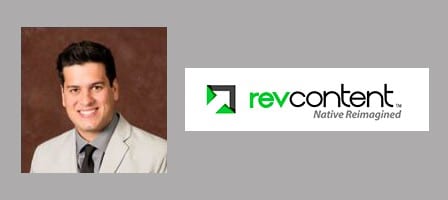Native advertising is not a new concept. From the first advertisement including long-form copy in the early 1900s, to TV infomercials introduced in the 1980s, consumers are used to seeing sponsored content. However, digital native advertising as we know it today dates back only to 2011.
With $21 billion estimated to be spent on native advertising by 2018, marketers can’t afford to misstep. Luckily, we can look to groundbreakers in the industry and learn from their experience. Relevance reached out to 14 active and well-respected professionals in the native advertising world and asked them:
“What are some native advertising mistakes marketers are committing?”
Here's what they had to say:

Richard Iwanik-Marques, Vice President of Marketing, LinkedIn
"Native advertising is a relatively young industry, and a lot of marketers are learning as they go, which we love at Revcontent. Testing new strategies and implementations for your marketing efforts are what drive data and new learning that will ultimately lead to sustainable and scalable revenues, engagement and brand awareness for marketers.
One trend I've seen all too often is marketers underestimating the importance of providing a value-added discovery experience to their audience. Instead of telling a story and relating to their audience, marketers moving into the native space are using traditional display experiences that don’t engage with a consumer and almost come off as a digital version of a billboard. The reason native is so effective as a means of driving brand awareness is the non-intrusive nature of the messaging. If you’re creating a campaign for native, put user experience at the forefront of your decision making. If the messaging doesn’t accomplish a true story-telling narrative for the people engaging with your content, it is highly unlikely you will accomplish the goals of your campaigns.”

David Osman, Co-founder and CEO, LinkedIn
"Programmatic native advertising supports content marketing. We’ve observed the following mistakes stemming from a misunderstanding of how in-feed native works:
Ben Young, CEO, @bwagy
"The most common pitfall marketers fall into is making their content too short. At Nudge we specialize in tracking native content and have our finger on the pulse of the market.
Content producers are too aware that it is advertising but are losing sight of the end user. The end user is browsing the web and clicks on an article they WANT to read. Don't hold back at 300-400 words: give them more of what you've got.
Half the battle is getting attention, so give yourself the opportunity to hold it when you get it."
Peyman Nilforoush, CEO and Co-founder, @ThePeyman
"Display advertising is a $100 billion industry that has failed miserably to engage consumers. Statistically speaking you have a better chance of surviving a plane crash than clicking on a banner ad. The average click-thru rate on a banner ad is 0.05%, meaning 99.95% of people who see a banner ad don’t click on it and they don’t work because they interrupt the user experience instead of enhancing it. That’s why the idea of native advertising has been revolutionary. Simply put, by giving users content that’s native to their experience the ad is now all of a sudden valuable to the user. This is why we’ve seen a dramatic shift of ad budgets from display/banner ads to native.
The biggest challenge, however, is making this change successful. It comes down to the idea that native advertising has to first and foremost be useful for the end consumer; it MUST offer value and it most certainly CANNOT BE DISRUPTIVE. There lies the biggest mistake that some of the world’s largest brands are making when it comes to native advertising:
While native advertising has been around for a few years, the implementation of it is still very new to the world’s largest brands. The opportunity for native advertising is to be synonymous with advertising, and it begins and ends with the consumer experience."
Adam Weinroth, CMO, @aweinroth
"One of the biggest overlooked opportunities in native advertising is thinking deeply about relevance. Amazon, Netflix, Google and others have conditioned consumers to expect a personally relevant experience everywhere they go online. If your native advertising program isn't part of a broader effort to get the most personally relevant content possible in front of the consumer, you might find yourself earning lots of impressions on attractive sites but potentially very little meaningful engagement that leads to actual business results. The best brands are working to make content resonate at the individual level, and having that relevance span across many different digital channels, not just one."
John Ferber, Chairman of the Board and Co-founder
"The most common mistakes advertisers make is that they either think they do not have content or they are using the wrong content. Many advertisers will use offer-driven content as a way to engage their audience when consumers engage in a deeper fashion with content that contains value. Value-driven content is educational, informative and engaging. Advertisers need to think more like publishers to be effective in the modern web."
Yaniv Makover, Co-founder, CEO, @YanivMakover
"Native advertising still frequently tends to come across as tone deaf to readers. Too often the material lacks cohesion with the rest of the publisher’s content, leaving the audience with a bad taste in its mouth. Consider a serious news outlet posting celebrity puff pieces for a brand shilling cosmetic creams. That disconnect shouldn’t exist in native advertising. In its best form, native advertising provides value to the reader and feels natural among its neighboring content. For the best shot at achieving this, brands might consider working with publishers’ in-house content studios, since they should have the deepest understanding of what resonates with their audiences."
Adam Singolda, Founder and CEO, @AdamSingolda
"As an industry, I think the main area where I see a big opportunity is to evolve from branded content or custom studios that were originally invented to drive high impact (“top of the funnel”), into measuring what happens when someone finishes reading a story.
I think we need to evolve from measuring “engagement” into metrics on actions, so marketers feel comfortable doing campaigns again and again. As an example, if someone spent 1- 2 minutes reading an article, should marketers do it again? I’m not sure, but if people sign up to the brand newsletter after they finish reading, that starts to become interesting. It demonstrates they want to stay in touch.
These are not traditional ROI metrics per se, but soft conversion metrics that can help both marketers and publishers work together and build meaningful partnerships."
Luke Kintigh, Global Paid Media and Content Strategist, @lukekintigh
"Many brands see the advent of native advertising simply as a new container for their digital ads. However, it is not the format that’s the real promise of native. Rather, it’s how native ads when done right match the format, function, and user expectation of the environments where they are placed. Unless the content inside native ads is as valuable and immersive as the natural content surrounding it, users will reject native ads just as they have with banners and other disruptive ad formats. As advertisers, we must have the mindset that our content can compete and even beat editorial content when it comes to quality and relevance to the end user. It is time to disrupt the age of disruption and show consumers that native advertising is much more than a new ad unit. Native has the capability to add value to the user instead of distracting from it.”
Will Fleiss, Head of Content Marketing, @willfleiss
"A glaring mistake I see marketers make with native advertising is when they only look at each piece of content from the campaign perspective, with a definitive beginning and end. Instead, native should be seen as part of an on-going content marketing strategy that aims to address the complete customer journey throughout the various stages of the funnel. Too often native advertising functions merely as another format for packing self-serving messages into the trusted places where audiences go to find relevant and interesting content when it should be about building a relationship with the consumer. That happens by consistently delivering valuable content that tells a story from one piece to the next."
Chad Pollitt, Co-founder, VP of Audience, @ChadPollitt
"The biggest mistake I’m seeing these days with native is the funnel alignment of content. Native is really good at scaled top-funnel content promotion. However, it’s not an effective channel when merely broadcasting mid to bottom-funnel content. That’s what PPC and display are for. Marketers need to use native to tell a story – only delivering mid-funnel content to the people who have consumed and engaged with top-funnel content already. As marketers, we need to respect the buyer’s journey. Native shouldn’t be treated like traditional paid digital channels. Don’t just hand an RSS feed over to the PPC guy and say figure it out. You’ll just waste money and moan about how native doesn’t work."
Jon Carmen, SVP of Operations, LinkedIn
"Not putting enough time and effort into ad creative. We see many advertisers that just try to re-purpose Display Ads into a Native Format. Unfortunately, it does not always translate. Native Ads need to be “headline interesting” but by no means 'deceptive.'
Advertisers may be overpaying because their vendor may be less adept at weeding out traffic fraud, which is now at epidemic proportions.
Many digital ad vendors have poor compliance programs which can place an advertiser’s offer in close proximity or adjacent to content or offers which would make most legitimate advertisers wince."
Todd Sawicki, CEO, @sawickipedia
"Advertisers’ biggest mistake with native advertising is applying last click thinking to a top of funnel solution. Native advertising allows marketers to connect users to content. Content helps generate awareness, interest and consideration, and now native advertising allows marketers the chance to market from the very top to the bottom of the funnel online - so start with native advertising to drive larger pools of users who are aware and interested in your product, and then close them with more last click oriented solutions like search marketing or display retargeting."
Jesper Laursen, Founder, @jesperlaursen
"Here are three of the common mistakes that we see way too often:
To end with a final piece of advice, David Ogilvy, the “Father of Advertising,” said, “It has been found that the less an advertisement looks like an advertisement and the more it looks like an editorial, the more readers stop, look and read.” Armed with this information, nothing can hold you back in creating phenomenal native advertising.